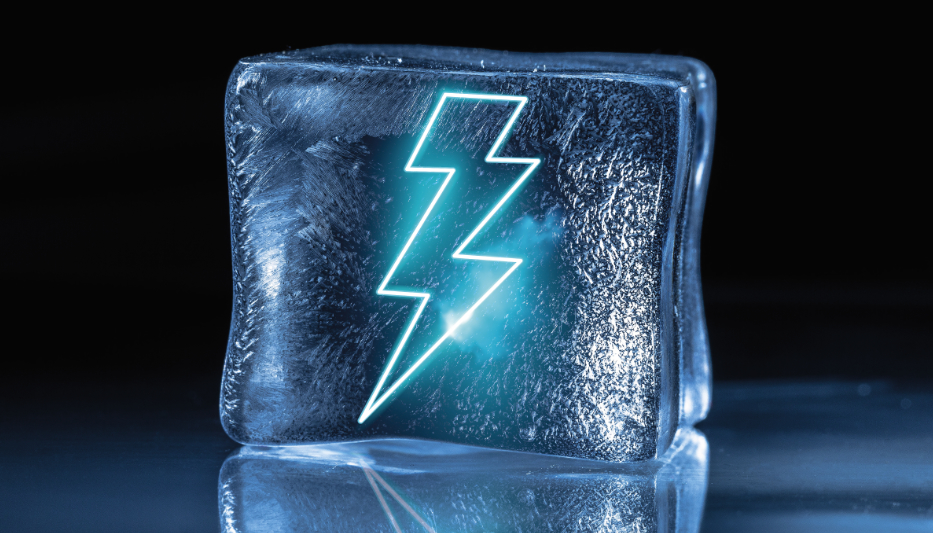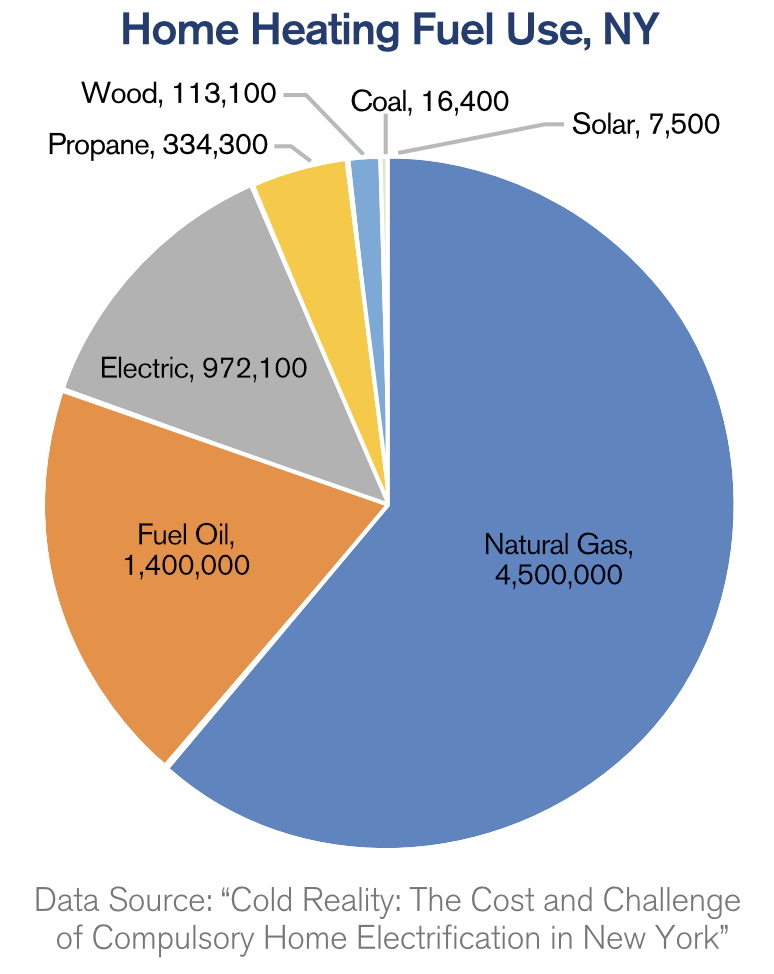All
Cold Hard Facts about Electrification
by James Cunningham

A new study looks at the cost of New York’s plans for compulsory electrification
It’s no secret that the move to electrify all power, whether it be home heating or the cars we drive, has become the trendy reaction to reducing carbon emissions and combating climate change. States have begun to take aggressive approaches to electrification in the form of legislation that aims to phase out any form of energy other than electrification. Among the states with the strictest legislation coming down the line is New York.
In 2019, Governor Cuomo passed the Climate Leadership and Community Protection Act (CLCPA), which established a goal to reduce greenhouse gas emissions by 40 percent from 1990 levels by 2030 and an 85 percent reduction by 2050, with the remaining 15 percent reduction coming from state created offsets.
A study released in early November paints a much different picture from the one politicians and utility companies are selling. In “Cold Reality: The Cost and Challenge of Compulsory Home Electrification in New York,” the Empire Center for Public Policy looked at the consequences that could follow a New York mandate of banning heating oil, propane, and natural gas from home heating after 2030. The conclusions could be startling to anyone who hasn’t been paying attention. Forced electrification could lead to sky-high prices on heat pump installation or energy-intensive electric furnaces, primarily affect lower- to middle-income families, add stress to already unreliable electrical grids, and completely eradicate propane and fuel oil home heating industries by the late 2050’s.
The Shock of Electric Heating
If heating oil, propane, and natural gas systems are banned in homes after 2030, homeowners would be left with two options: heat pumps or electric resistance furnaces. It is a bit of a “pick your poison” situation: shell out thousands of dollars upfront for a heat pump system or pay for those costs over time in the form of huge electricity bills from an electric furnace.
While heat pumps have high efficiency ratings, they don’t provide the same heat output as an oil furnace or boiler and require extensive weatherization of homes to retain what little heat they do provide. Add that to the cost of a heat pump system, with homeowners spending anywhere between $14,600 to $46,200, and it can take 8 to 19 years to recover costs through their energy savings, the study says. It isn’t exactly a quick return on investment.
Because these upfront numbers will be alarming to most people, many homeowners will instead opt to go with electric resistance furnaces. These furnaces work by using electricity to heat internal coils, and the heated air is then blown through the home’s ductwork. While the upfront cost is significantly lower than for a heat pump; unlike heat pumps, which pull their heat from a source like the air outside, electric-resistant furnaces use electricity to generate their heat, which can send utility bills skyrocketing. According to the study, even with higher annual energy costs, it could take 18 to 60 years for total costs to equal the cost of a heat pump installation plus home weatherization.
These figures are tough to swallow for several reasons. Not only will these new regulations completely diminish any energy independence that homeowners have, but it will also force them to spend thousands of dollars on an entirely new system they might not even want.
Current Energy Breakdown of New York Homes
As it stands in New York, there is an eclectic use of energy across the state. According to the findings in the study, energy sources for home heating in residential units are:
- Natural Gas – 4.5 million
- Fuel Oil – 1.4 million
- Electric – 972.1 thousand
- Propane – 334.3 thousand
- Wood – 113.1 thousand
- Coal – 16.4 thousand
- Solar – 7.5 thousand
Electricity and solar energy account for only 13 percent of residential heat in New York State. If the ban on gas, heating oil, and propane were to go into effect in 2030, it would require the compulsory electrification of 6.2 million heating units up and down the state. The report states that under this scenario, propane furnaces effectively disappear by 2047, and fuel oil furnaces, due to their longer operational lifespan, will completely disappear by 2056. In other words, a full-throttle switch to electrification would effectively put the liquid home heating fuels industry out of business.

The Issue of Grid Reliability
The elephant in the room is the dreaded question of grid reliability. It’s worth noting that the vast majority of our electric grids were constructed 50 or 60 years ago and built to run on fossil fuels. Without consistent maintenance, repair and upgrades to our electrical grids, the results of a full-fledged switch to electrification would come with devastating results.
Look at what happened during the 2021 power crisis in Texas that left more than 4.5 million people without power, some for days, during what has become known as “The Great Texas Freeze.” As temperatures plummeted, people turned to their electric heaters for warmth. Despite Texas having generated the most electric power of any state in 2021, according to the EIA, the extreme demand and temperatures nearly collapsed the entire grid. Today, severe weather events such as “The Great Texas Freeze” have become the norm rather than an anomaly. It begs the question, would putting more strain on the grid be a feasible option for families and businesses across the country?
An eye-opening announcement was released by the North American Electric Reliability Corporation (NERC) on November 8, 2023. It found that much of North America is once again at an elevated risk of having insufficient energy supplies to meet demand in the face of extreme weather events. Mark Olson, NERC’s Manager of Reliability said, “As electric heat pumps and heating systems become more prevalent, their combined effect on system demand is even more pronounced.”
While the report states that New York and NPCC-NE are expected to meet operating demand under normal peak demand scenarios this winter, it found that grids over much of the eastern two-thirds of the continent will be at an elevated risk. It doesn’t help that many of the central and eastern states are projected to suffer a more severe winter due to the El Niño patterns coming from the Pacific Ocean. It remains to be seen how grids will hold up, but NERC is putting everyone on alert.
The report also includes this warning: “Load forecasting in winter is growing in complexity. Underestimating demand is a risk to reliability in extreme cold temperatures. Extreme cold temperatures and irregular weather patterns characterized by strong cold fronts, wind, and precipitation can cause demand for electricity to deviate significantly from historical forecasts.” In simple terms, they’re giving best guesses, but it could be a lot worse.
The NERC report offers a double-edged sword to other regions, as well, such as this entry on PJM Interconnection, which provides energy for 65 million consumers across the mid-Atlantic region. “Installed capacity is significantly higher (13 percentage points) than PJM’s Reserve Requirements. PJM does not expect to encounter resource problems for anticipated conditions over the 2023–2024 winter Peak season. A severe cold weather event that extends to the South can lead to energy emergencies as operators face sharp increases in generator forced outages and electricity demand. Forecasted peak demand has risen while resources have decreased since 2022 when Winter Storm Elliot caused energy emergencies in PJM and surrounding areas.”
What About Renewable Fuels?
From the Providence Resolution to the widespread acceptance of lower-carbon fuels and higher efficiency equipment, to the inclusion of B100 standards for equipment safety and certification, and the roll-out of B100 compatible burners, the liquid heating fuels industry has proactively responded to growing concerns about the climate and greenhouse gas emissions.
New York has been one of the most aggressive East Coast states in accepting and legislating the use of biofuel blends. The downstate region, encompassing New York City and Nassau, Suffolk and Westchester counties, has had a B5 mandate for years. Statewide regulations took effect this past July 1.
“State and federal legislators are putting their fingers on the scale for electric heat over the immediate and lower cost solution of renewable liquid fuels and high-efficiency heating equipment. This push for electrified heat will increase greenhouse gas emissions and raise the costs to repair or replace home heating systems beyond the reach of most homeowners,” said Sean Cota, president of the National Energy & Fuels Institute (NEFI).
Renewable liquid heating fuels are an immediate solution that can work congruently with other renewable energy solutions. Integrations of B100 heating oil and solar power have proven the net-zero home heating concept. Split system homes, which can run traditional heating systems or heat pumps, offer the highest energy and cost efficiencies possible.
The conclusion of the “Cold Reality” study goes on to say, “By choosing a single model for all homeowners to follow, the state’s Climate Action Council closed the door on the potential to reduce greenhouse gas emissions through the use of clean fuel standards using fuels supplied by an existing distribution system.”
These existing distribution systems are the local and family-owned businesses that dot main streets and contribute to communities from the foothills of the Adirondack Mountains down to the beachy shores of Long Island in New York, but this holds true for liquid fuel retailers across the country. Many have been pillars in their communities for over a century. Their customers aren’t simply account numbers as in big utility companies. They are friends, neighbors, and people who trust them to provide their families with safe and reliable home comfort no matter what. That is something no politician or piece of legislation can put a price on.
Related Posts
 National Energy Choice Legislation Advances Through Committee
National Energy Choice Legislation Advances Through Committee
Posted on November 20, 2025
 New and Improved: NEFI Member Benefits Deliver More Value
New and Improved: NEFI Member Benefits Deliver More Value
Posted on October 17, 2025
 It’s Upgrade Season. Get the Sale.
It’s Upgrade Season. Get the Sale.
Posted on October 16, 2025
 The Value of Providing Value
The Value of Providing Value
Posted on October 16, 2025
Enter your email to receive important news and article updates.
